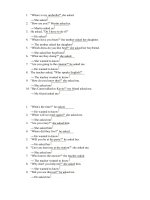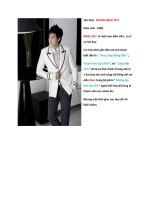bài tập anh văn thcsthpt sương nguyệt anh
Bạn đang xem bản rút gọn của tài liệu. Xem và tải ngay bản đầy đủ của tài liệu tại đây (145.4 KB, 3 trang )
<span class='text_page_counter'>(1)</span><div class='page_container' data-page=1>
<b>ÔN LUYỆN TIẾNG ANH 12 </b>
Tuần từ 20-25/4
<b>Choose the best answer </b>
1. I ______ to the shops, but I ______ anything because I ______ my wallet.
a. go / cannot buy / will lose b. was going / did not buy / have lost
c. am going / am not buying / will lose d. went / could not buy / had lost
2. I _______ well recently. I _______ to see my doctor yesterday. He said that I _______ some rest.
a. do not sleep / went / would need b. have not slept / went / needed
c. did not sleep /go / will need d. had not slept / went / had needed
3. They _______ him for weeks.
a. do not see b. did not see c. have not seen . will not have seen
4. Every day Mary _______ on the computer, but today she _______ a typewriter because there is no power.
a. types / is using b. is tying / uses
c. has typed / will use d. types / has used
5. She said that she hadn't visited the UK _______.
a. before b. then c. now d. ago
<b>Error Identification. </b>
6. Facial expression involves some of smallest body movements, but its
A B
impact may be greater than any other body language.
C D
7. Smiles arid grimace can be very effective used in conversation,
A B
but more commonly, we do not tend to think that nonverbal physical
C D
response may be communicating.
8. I believe that only very self-confident, knowledge and attentive students
A B
will prefer 100% of eye contact time.
C D
9. Teachers often use eye contact in the classroom to decide who is
A B C
prepared to answer a question, or that didn't complete his homework assignment.
D
10. Beside words the human face is the primary source of information for
A B C
</div>
<span class='text_page_counter'>(2)</span><div class='page_container' data-page=2>
D
Read the passage carefully and choose the correct answer.
Body postures and movements are frequently indicators of self-confidence, energy, fatigue, or status.
Cognitively, gestures operate to clarify, contradict, or replace verbal messages. Gestures also serve an important
function with regard to regulating the flow of conversation. For example, if a student is talking about something in
front of the class, single nods of the head from the teacher will likely cause that student to continue and perhaps more
elaborate. Postures as well as gestures are used to indicate attitudes, status, affective moods, approval, deception,
warmth, arid other variables related to conversation interaction.
The saying "A picture is worth a thousand words" well describes the meaning of facial expressions. Facial
appearance - including wrinkles, muscle tone, skin coloration, and eye color-offers enduring cues that reve1il
information about age, sex, race, ethnic origin, and status.
A less permanent second set of facial cues-including length of hair, hairstyle, cleanliness, and facial hair-relate
to an individual's idea of beauty. A third group of facial markers are momentary expressions that signal that cause
changes in the forehead, eyebrows, eyelids, cheeks, nose, lips, and chin, such as raising the eyebrows, wrinkling the
brow, curling the lip.
Some facial expressions are readily visible, while others are fleeting. Both types can positively or negatively
reinforce the spoken words and convey cues concerning emotions and attitudes.
11. Gestures _________.
a. can do nothing with a conversation
b: can clarify the meaning of verbal messages.
c. may interrupt the flow of a conversation
d. can end a conversation more quickly than usual
12. A nod of the head from the teacher will likely ask his student to _______ what he is saying.
a. go on b. give up c. put off d. throwaway
13. According to the writer, "A picture is worth a thousand words" means _______.
a. a picture of a face is more valuable than a thousand words
b. a picture is more important than a thousand words
c. facial gestures can convey a lot of meanings
d. he has just bought a picture with a thousand words on it
14. How many categories of facial expressions are mentioned?
a. 2 b. 3 c. 4 d. 5
15. Facial expressions _________.
a. cannot convey emotions b. cannot reinforce spoken words
c. can only express negative attitudes d. can be either visible or fleeting
<b>Fill in each numbered blank with one suitable word or phrase. </b>
The most dominant and reliable features of facial expressions provide a constant channel of communication. They
can be shifty and evasive; convey hate, fear, and guilt; or (16) _____ confidence, love, and support
</div>
<span class='text_page_counter'>(3)</span><div class='page_container' data-page=3>
_____ dictionary, but it is understood all over the world. When the eyes say one thing, and the tongue another, a
practiced man relies on eyes. Except (20) _____ extremely shy individuals, most people look for social acceptance
by studying the eyes of others. Eyes also can (21) _____ indicate a positive or a negative relationship. People tend
to look longer and more often at the people whom they trust, respect and care about than at those whom they doubt
or (22) _____. Normal eye dilation is not under control of the individual. Personally characteristics such as
introversion and extroversion also influence eye behavior. Eye behavior seems (23) ____ particular importance and
is generally used to indicate whether one is open to communication. This can be observed when a teacher asks the
class a question: students who think they know the answer will generally (24) ____ at the teacher, (25) ____ students
who do not know the answer will usually try to avoid eye contact.
16. a. replace b. report c. consider d. express
17. a. interpreting b. changing c. exchanging d. transporting
18. a. much b. many c. more d. a lot
19. a. not b. nor c. no d. none
20. a. in b. for c. of d. with
21. a. accurate b. accuracy c. accurately d. inaccurate
22. a. love b. long c. wait d. dislike
23. a. to be b. be c. being d. been
24. a. notice b. look c. think d. aim
</div>
<!--links-->









